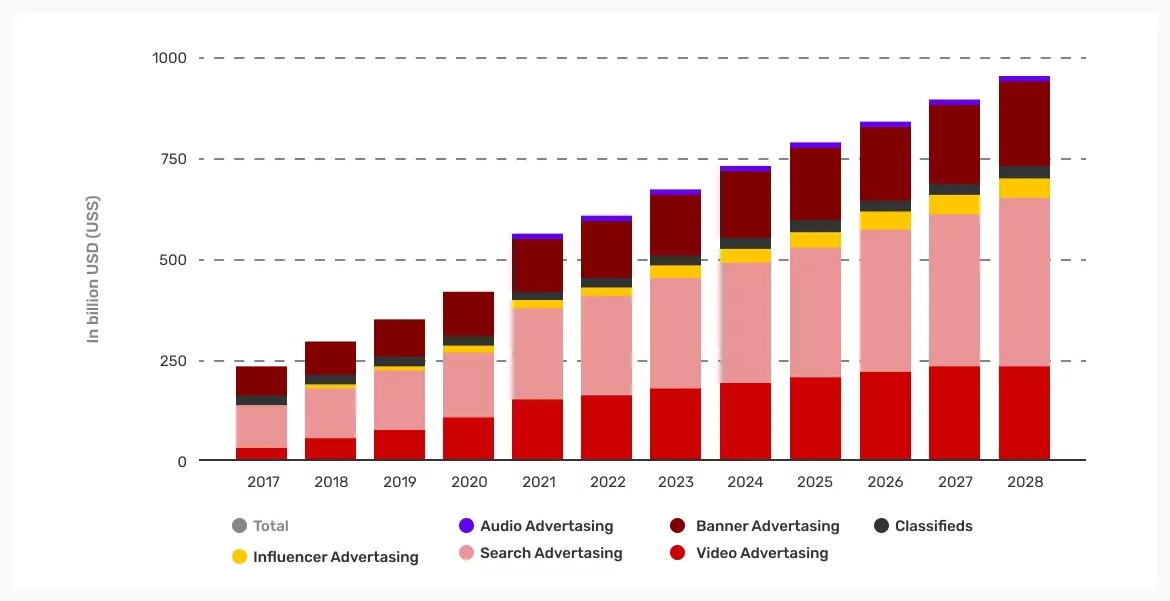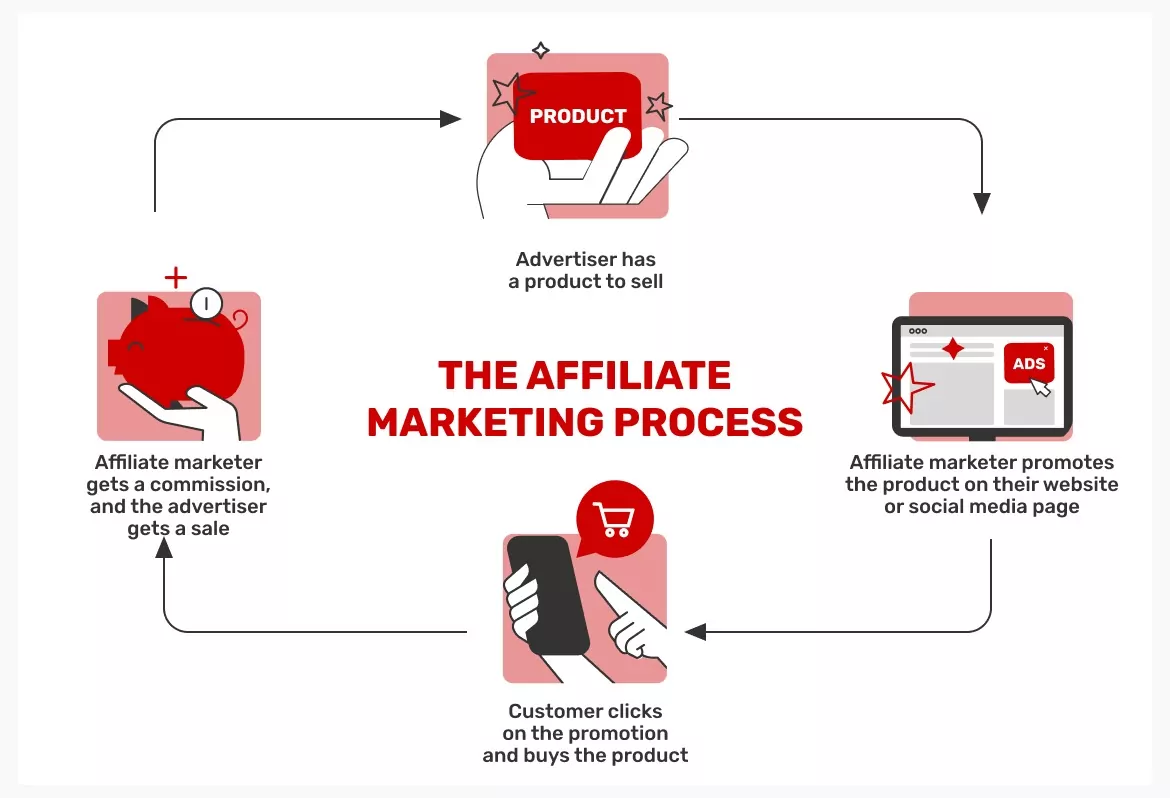It’s one thing to buy ad space for a product or service you’re promoting, and it’s another to do it effectively. Buying ad space that’ll yield good results requires you to focus on specific criteria, e.g., choosing the best ad network and the kind of creatives to use.
If buying ads seems complicated for you, you’ve come to the right place. We’ll show you how to buy ad space strategically and get excellent results!
Why do marketers purchase advertising space?
Marketers buy advertising space to sell their products to an audience. No matter how good your product or service is, it’s of no use if people don’t hear about it.
Online advertising is a huge and still booming industry. According to Statista, the digital advertising market is projected to grow from $680 billion in 2023 to $966 billion in 2028, as shown in the below chart.

It helps that anyone can now find a relevant ad network and set up an ad campaign with a few steps. Marketers take advantage of this ease to create effective advertising campaigns.
How to plan your ad space purchase
Effective advertising placement requires meticulous planning. Below is a step-by-step guide to go about it.
1. Define your advertising goals
The crucial first step is defining exactly what you want to achieve from your ads. The goals determine the direction of your advertising campaign and how you evaluate its success. Factors to consider include:
- Define the business objective: What do you want to gain from your ads? Is it to increase sales or to improve long-term brand recognition? Are you promoting a new product that needs to be seen? Understanding the objectives will guide your advertising campaign.
- SMART goals: SMART is a widely accepted goal-setting criterion demanding that your goals be Specific, Measurable, Achievable, Relevant, and Time-Bound. In other words, your media buying goals should be well-defined, feasible, and have a realistic timeline for completion.
- Define your Key Performance Indicators (KPIs): KPIs are the metrics you’ll use to evaluate the success of your advertising campaign. Examples include the percentage increase in sales, website traffic, number of new signups, app downloads, social media followers, etc.
These are common types of advertising goals:
- Awareness: To generate interest in a new product or service.
- Conversion: Driving specific consumer actions, e.g., newsletter signups, account creation, app downloads, website visits, etc.
- Retention: Targeting previous customers with ads to encourage them to patronize you again.
2. Identify your target audience
The next step after defining your advertising goals is to identify the perfect target audience for your ads. No matter how well-defined and creative your ads are, they’ll not work if targeted at the wrong audience. Below are the factors that help you choose the right audience for your campaign:
- Analyze your competitors: Draw a list of your main competitors and monitor their target audience. You don’t have to copy them verbatim, but competitors give you a clue about the right audience for your product or service.
- Analyze existing customers: If you already have customers, you can use them as a starting point. Analyze their demographics; what age, gender, and location buy your products the most?
- Understand what you’re selling: What solution is your product offering? Who is it designed for, and who will get the best benefit from it?
- Create a customer profile: With the information from the above steps, you can create what you consider to be an ideal customer profile. A profile can include details about their age, gender, career, purchasing power, interests, etc.
- Market research: You can conduct market research to refine your customer profile, e.g., surveys and interviews.
- Testing and refining: Your target audience doesn’t stay the same forever. You’ll likely need to test and refine it over time as you collect more insights about your customers.
3. Research and choose good ad platforms.
With your target audience defined, the next step is to research the best ad platforms to place your ads. Some ad networks cater to specific audiences, while others cater to a general audience.
Factors to consider when choosing an ad network include:
- Ease of use: You need an advertising platform that’s easy to navigate.
- Size: What level of traffic can the network provide for your ads? Some networks specialize in small niches, while others provide access to a large network of websites.
- Advertising formats: What ad formats does the platform support? Do the formats fit the type of ads you want?
Adsterra is a good example of an advertising network to get good results. We connect you to a network of high-quality websites across different niches. Our 28,000+ publishers deliver 32+ billions monthly ad views, providing ample opportunities for advertisers in iGaming, E-Commerce, Utility, Software, and many other niches.
Adsterra offers a self-serve ad platform, allowing marketers to purchase traffic quickly. Yet, if you need extra support, we can provide it 24/7. Supported ad formats include Popunders, Banners, In-Page Push, and Social Bar.
4. Set a budget
With an advertising network in mind, the next step is to choose a budget for your ad campaign. Here are the factors to help you choose an appropriate budget:
- Income: Consider your business’s revenue and profit margins. How much can you realistically spend on advertising without breaking the bank?
- Customer lifetime value (CLV): Consider how much you expect to earn from a single customer over their lifetime with your business. This critical figure helps you determine how much you will spend to acquire a new customer. The rule of thumb is to spend 20% to 30% of your CLV to acquire a new customer.
- Production costs: Are you hiring external help for your ads? Help can include copywriting, video production, graphic design, etc.
- Adjustments: You can set aside some money for unexpected expenses during your campaign, e.g., setting a new target audience.
5. Consider advertising creatives and messaging
The last stage is to work on your advertising messaging and creatives. What type of ad formats will you choose? How will you differentiate your product from the competition? How can you nudge viewers to follow your suggested action?
Factors to consider include:
- Be clear and precise: Your advertisement should be simple to understand. The viewer should be able to decipher what you’re selling at a glance. Avoid overly complex terms and industry jargon.
- Evoke emotion: Tap into your audience’s emotions to market your product. Emotional triggers make it easy for viewers to relate to your advertisement.
- Define your selling point: What characteristics make your product stand out from the competition? You should center your ads around these unique characteristics.
- Use a call-to-action (CTA) button: Prompt viewers to take a specific action after viewing your ad. You don’t want people liking your ad but getting confused about what to do next.
Selecting the right ad space
After planning your advertising strategy, selecting the right ad space is the next critical step. Below are the key steps to take:
1. Researching and analyzing available ad spaces
You need to research the available spaces on your chosen ad network. What ad formats do they support, and what are their sizes?
For instance, Popups come in different sizes for desktops and smartphones. If you want to advertise primarily to mobile users, ensure your chosen ad network supports the optimal sizes for smartphones and tablets (360×660, 340×200, etc.). Otherwise, you might deploy ads that are too small or too large and, consequently, generate poor results.
2. Negotiating ad space rates
After choosing the right ad spaces for your campaign, the next step is looking at the rates your chosen ad network charges for those spaces. Different ad networks have different pricing strategies. The price usually depends on many factors, including location, target audience, device type, etc.
If permitted, you can negotiate the pricing terms with your advertising network and snag the best deal to maximize your return on investment.
3. Ensure compatibility with brand image
Advertisers must ensure their ad spaces are compatible with their brand image. You don’t want your ads appearing next to illegal and harmful content, e.g., unregulated wagering sites, phishing websites, drug paraphernalia, etc. Ensure your chosen ad network gives you access to ad space from reputable, high-quality websites
Fortunately, Adsterra fits this criterion. We give advertisers access to a global network of thousands of publishers across different niches. Adsterra is a smart choice for advertisers who want to enter a new market and run global-reaching campaigns for their products.
4 proven approaches to buying ad space
1. Manual buying
You can buy ad placement directly from a website owner. You’ll negotiate a deal directly with the website publisher, bypassing an intermediary that collects extra fees. Many websites have “Advertise with us” links or something similar that directs interested advertisers to fill out a form or send an email to inquire about ad deals.
The drawback of this method is that it’s usually reserved for high-spending buyers. If you propose a low ad budget, website owners will be reluctant to engage with your brand.
| Pros | Cons |
|---|---|
| You can form long-lasting relationships with website publishers | Requires considerable effort |
| No fees are collected by an intermediary | Often expensive |
2. Use an ad network
You can use an ad network that gives you access to high-quality publishers. The network takes care of sourcing ad space and inventory; your job is to supply and pay for the ads. The platform handles the negotiations with publishers and saves advertisers the effort.
With a reliable ad network, you won’t spend time negotiating ad deals. Everything has been set up for you, and you can advertise with low budgets. The network acts as an intermediary between advertisers and publishers and collects fees for their service.
| Pros | Cons |
|---|---|
| Saves time | Some ad platforms charge high fees |
| Easy to deploy your ads |
3. Affiliate marketing
Affiliate marketing is a model where an advertiser offers commissions to affiliate marketers who promote their products and generate sales. You partner with a professional affiliate marketer and agree to pay a specific commission for each sale they generate for your brand.

Affiliate marketing can be lucrative if done right, and the primary advantage is that you don’t pay any fees unless a sale occurs. You can join a reputable affiliate network to find expert marketers in your industry.
| Pros | Cons |
|---|---|
| It’s low-risk because you don’t pay until a sale occurs | It can take a long time for advertisers to master |
4. Programmatic advertising
Programmatic advertising is an automated media buying process. It’s centered on a platform where advertisers provide ad creatives and bid for spaces on websites in real time. You can bid against advertisers through real-time auctions; the highest bid every second or so gets the ad space.
| Pros | Cons |
|---|---|
| A transparent ad bidding process | No human in the loop, meaning costly mistakes can be easily overlooked |
| You get real-time insights on ad results |
Checklist for buying ad space
If you want to buy ad space manually, the three most critical factors to consider are traffic, content, and search engine visibility.
Traffic
What level of traffic does the website have? The more traffic the website receives, the more people will see and respond to your ads. You can ask for detailed traffic reports from the website owner to help you decide if the site suits your ads.
Content
What content does the website post? The content must be relevant to the product you’re promoting, or your ads won’t get good results. For example, if you’re advertising jewelry and accessories, a fashion blog is your best choice.
Visibility
How visible is the website to search engines? Search engines are the number one source of high-quality organic traffic. Hence, the website you buy ads from should rank high for relevant keywords in your niche. High rankings improve the chances of getting positive results from your ads.
FAQs about buying ad space
There’s no definitive answer to this question. Ad space can be as low or as high as possible. It depends on many factors, including the website, location, target audience, type of product, etc.
The first step is to determine the customer lifetime value (CLV), the total revenue you expect to generate from a customer over their lifecycle. You calculate this metric by multiplying the average value of sale X the average number of transactions X the average customer lifespan. A good rule of thumb is to budget between 20% and 30% of your CLV for each new customer acquisition.
The average click-through rate for online ads is between 1% and 5%. You should aim for something above average; 5% to 10% is a good goal.
Conclusion
Buying ad space requires considerable planning and execution. You might have the budget, but it’s of no good if you don’t strategically plan your ad-buying process. We’ve explained how to buy ad space effectively and the proven methods to go about it.
Above all, ensure you choose a reliable ad network that gives you access to high-quality traffic and your intended target audience. Luckily, Adsterra is one such network, with a network of reputable websites across many industries and 24/7 support to help advertisers achieve their goals.
